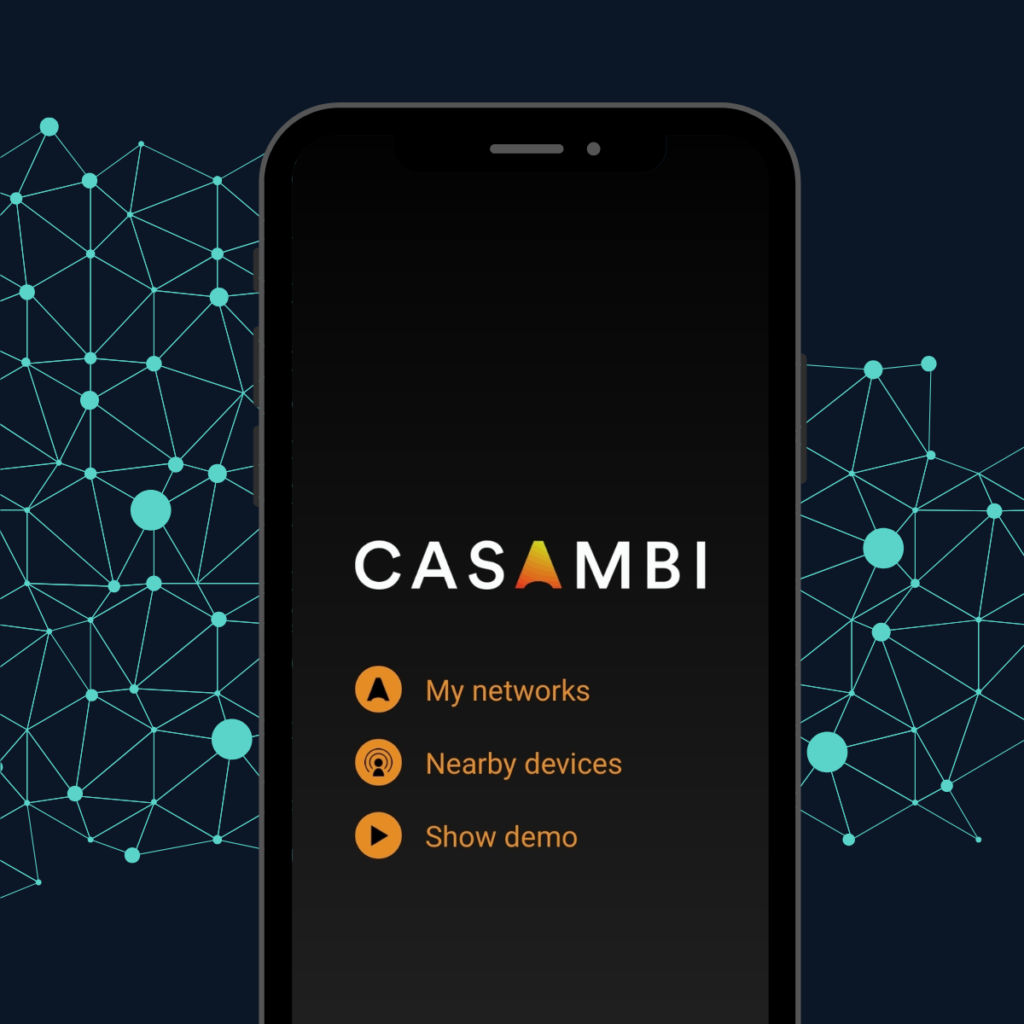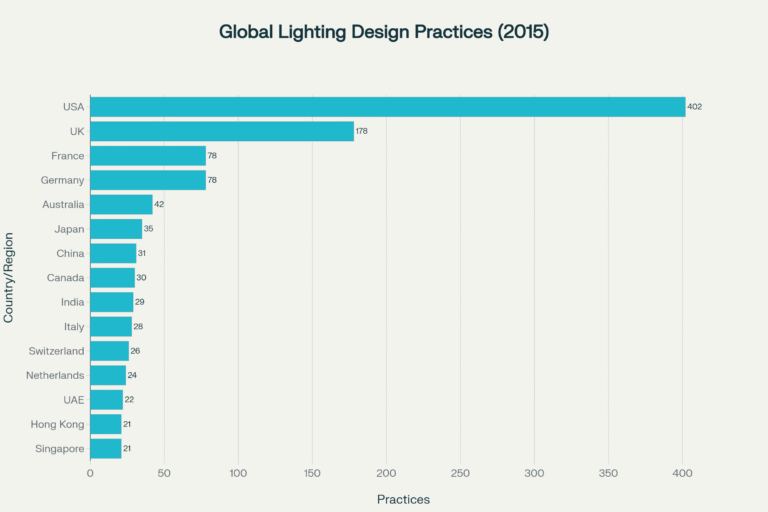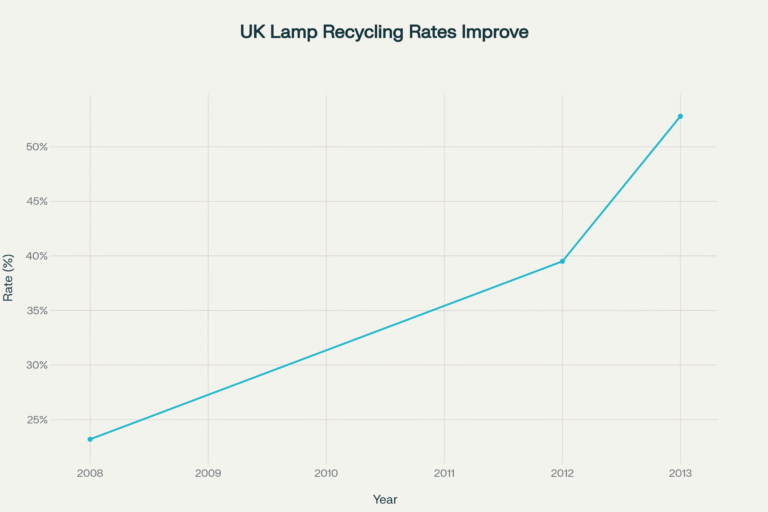
Smart Office Lighting Control with Casambi
Transform your workspace with lighting that actually works for you. Cut energy bills, boost productivity, and give your team control over their environment—all through a free app.
What is Casambi Lighting Control?
Casambi is a wireless lighting control system that uses Bluetooth mesh technology to connect your office lights. Unlike traditional systems that require complex wiring and expensive controllers, Casambi turns each light into a smart node that communicates with nearby fixtures, creating a self-healing network across your entire workspace.
At Lumenloop, we manufacture sustainable LED luminaires with Casambi built in. Power them on, download the free app, and you’re controlling your office lighting from your smartphone. No gateway boxes, no specialist installation, no ongoing fees.
Why Offices Are Switching to Casambi-Controlled Lighting
Slash Energy Costs by Up to 47%
Lighting accounts for approximately 20-40% of total energy consumption in commercial buildings. Smart lighting control systems with Casambi deliver average energy savings of 47% across all building types, with some installations achieving reductions between 30-60%.
Occupancy sensing automatically detects when spaces are empty and dims or switches off lights, delivering 24% average energy savings. Private offices see 13-50% reductions, while storage areas and warehouses achieve 30-90% savings.
Daylight harvesting uses sensors to measure natural light levels and automatically adjusts artificial lighting to maintain optimal illumination. This strategy delivers 28% average energy savings, with studies showing 30-40% reductions in spaces with good window access.
Combined approaches—integrating occupancy detection, daylight harvesting, and personal control—achieve 38% average energy savings.
Eliminate Rewiring Costs and Disruption
Traditional wired lighting control systems require extensive cabling, surface reconstruction, and lengthy installation times that disrupt business operations.
Wireless lighting control with Bluetooth mesh removes these barriers entirely.
Installation costs drop significantly without control wiring. Labor expenses decrease, material costs reduce, and business operations continue uninterrupted during installation. For retrofit projects in occupied buildings, wireless systems are particularly advantageous.
Wireless lighting controls save between $0.60 to $1.00 per square foot in energy costs and can deliver 41% overall cost savings in office environments, with typical payback periods of just 2-3 years.
Boost Employee Productivity and Wellbeing
Office lighting directly impacts productivity, mood, and health. Poor lighting causes eye strain, headaches, reduced concentration, fatigue, and stress.
Personal lighting control empowers employees to adjust brightness and colour temperature based on individual needs and tasks. Studies demonstrate that environmental control—including lighting—improves perceived productivity and job satisfaction.
Circadian lighting mimics natural daylight patterns by adjusting colour temperature and intensity throughout the day. Cool, bright light (5000K+) in the morning increases alertness by 25%. Warmer light (2700-3000K) in late afternoon supports natural wind-down rhythms.
Research shows circadian lighting in offices improves sleep quality, reduces stress, enhances focus, and can result in a 12% productivity gain. Employees with access to natural light features experience 63% fewer headaches, 51% less eyestrain, and 56% less fatigue.
Reconfigure Spaces Without Electrical Work
Office layouts change. Meeting rooms become hot desks. Open plans get subdivided. With traditional wired systems, every spatial reconfiguration requires electrical contractors and expensive rewiring.
Casambi’s wireless architecture makes space reconfiguration simple. Create new lighting zones, reassign fixtures to different groups, and adjust scenes entirely through the app. No walls need opening, no cabling requires moving, no electricians are needed for basic reconfigurations.
How Casambi Works in Your Office
Bluetooth Mesh Networking Explained
Bluetooth mesh networking connects devices in a many-to-many relationship where each light fixture (node) can communicate with nearby nodes. When you send a control command, it propagates through the mesh, reaching all intended fixtures even if some are beyond direct Bluetooth range.
This decentralized architecture eliminates single points of failure. If one node fails, the network routes around it automatically. The mesh is self-healing and scalable, supporting hundreds or thousands of nodes without degrading performance.
Unlike WiFi-based systems, Bluetooth mesh uses two-way communication, allowing each device to both send and receive data. This enables real-time status updates and ensures commands are confirmed.
Simple Setup and Commissioning
First-time setup takes minutes:
Power on Casambi-enabled Lumenloop luminaires
Download the free Casambi app (iOS/Android)
Open the app—it automatically discovers all powered Casambi devices within Bluetooth range
Tap “Take all lamps into use”
The app creates a network and adds all fixtures automatically
Commission remotely through the app—ideal for occupied buildings where site visits are disruptive. Direct mobile device provisioning eliminates specialized engineering expertise and internet/cloud access requirements during installation.
For larger projects, use Casambi Pro (desktop/iPad) for template-based deployment across multiple sites, advanced scheduling, and centralized management.
Control Options That Suit Your Team
Free Casambi app (iOS/Android): Adjust brightness, change colour temperature, activate scenes, create schedules, and view real-time status
Wireless wall switches: Battery-free switches using energy-harvesting technology stick anywhere without wiring. Configure through the app to control individual lights, groups, or activate scenes
Occupancy and daylight sensors: Wireless sensors pair seamlessly with the Casambi network for automatic presence detection and daylight harvesting
Building management system (BMS) integration: Optional gateway enables integration with existing BMS via standard protocols
Key Features for Modern Offices
Flexible Zoning Without Physical Constraints
Group fixtures into zones based on function, not physical location. Conference rooms, open-plan zones, private offices, circulation areas, and break rooms each get custom control settings.
Software-based zoning means zones can be redefined instantly as your office evolves. No rewiring, no physical zone controllers—just tap and reassign in the app.
Scene Creation for Different Activities
Create unlimited scenes (up to 255 per network) for different times of day or activities:
Morning energize: Bright, cool light (5000K) at full brightness
Focused work: Moderate brightness with task lighting emphasis
Collaboration mode: Uniform lighting across meeting spaces
Presentation mode: Dim perimeter lights, maintain screen wall brightness
Evening wind-down: Warm, dimmed light (2700K) at 30% intensity
Activate scenes manually through the app, via wireless switches, automatically with sensors, or on schedule via timers.
Automated Scheduling and Timers
Set lighting to automatically adjust throughout the day. Schedule brightness and colour temperature changes to follow natural circadian patterns—cool and bright in the morning, gradually warming and dimming toward evening.
Time-based scheduling automatically turns lights off during non-business hours and weekends, eliminating wasted energy from lights left on overnight. Configure weekday vs. weekend schedules separately.
Occupancy-Based Automation
Occupancy sensors detect movement and automatically turn lights on when people enter and off after spaces remain vacant for a set duration.
Vacancy sensing (manual-on, auto-off) provides even greater savings by requiring occupants to manually activate lights, eliminating false triggering while still ensuring lights don’t stay on in empty rooms. Private offices achieve 13-50% savings, while storage areas see 30-90% reductions.
Daylight Harvesting
Daylight harvesting sensors continuously measure ambient light levels (lux) and adjust electric lighting to maintain target illumination. As natural daylight increases, artificial lighting automatically dims proportionally.
This strategy is most effective in perimeter zones near windows, where natural light penetration is greatest. Installations with continuous dimming photo sensors achieve 30-40% lighting energy savings.
Personal Tuning and Individual Control
Personal tuning allows individual employees to adjust lighting at their workstation based on personal preference, visual acuity, and task requirements.
This feature delivers 31% average energy savings while simultaneously improving comfort, satisfaction, and productivity. Employees given lighting control report better mood, reduced stress, and increased perceived productivity.
Real Office Applications
Open-Plan Workspaces
Software-defined zones create lighting areas that don’t follow structural walls. Perimeter zones near windows use daylight harvesting to reduce artificial light automatically. Interior zones rely on occupancy sensing to ensure lights activate only when desks are occupied.
Personal control at workstations lets employees fine-tune their local environment without affecting neighbors. Group control enables facilities teams to adjust entire zones simultaneously for cleaning, maintenance, or special events.
Private Offices and Focus Rooms
Personalized presets save individual lighting preferences. One-touch scenes like “video call,” “reading,” or “deep work” adjust brightness and colour temperature instantly.
Automatic welcome/goodbye scenes turn lights on when occupants arrive and off shortly after they leave, eliminating wasted energy from forgotten switches.
Meeting and Conference Rooms
One-touch scene switching transforms lighting for different activities:
Presentation mode: Dims lights near screens, maintains illumination elsewhere
Video conferencing: Even, flattering light on participants, reduces screen glare
Collaboration mode: Bright, uniform lighting throughout the space
Break mode: Dimmed, warm lighting for informal discussions
Occupancy-based control ensures lights don’t remain on in vacant meeting rooms between bookings, delivering 40-46% energy savings.
Corridors, Circulation, and Back-of-House
Occupancy sensing is particularly effective in circulation spaces. Corridors see 30-80% energy savings when lights automatically activate only during foot traffic.
Scheduled dimming reduces lighting levels during low-traffic periods (evenings, weekends) while maintaining minimum safety illumination. Emergency lighting integration ensures code compliance while minimizing energy use.
Storage, Archives, and Utility Spaces
These rarely-occupied spaces waste significant energy when lights remain on unnecessarily. Occupancy sensors deliver 30-90% savings by ensuring lights activate only when someone is present.
Time-scheduled lockouts can prevent lights from turning on during off-hours except when manually overridden for scheduled access.
Environmental and Sustainability Benefits
Lumenloop manufactures sustainable LED luminaires using circular economy principles—designing for longevity, repairability, and end-of-life recovery.
Pairing sustainable manufacturing with Casambi lighting control amplifies environmental benefits:
Energy reduction: 30-60% typical savings means substantial carbon footprint reductions. A 50,000 sq ft office reducing lighting energy by 50% can save over 52,000 kWh annually, equivalent to approximately 21 metric tons of CO₂.
Extended luminaire lifespan: Dimming reduces heat generation in LED drivers—the primary failure mechanism. Lights operating at reduced levels last significantly longer, delaying replacement cycles and reducing material consumption.
Lower HVAC load: LEDs generate minimal heat compared to legacy lighting. Reduced lighting heat output decreases cooling demand, creating additional energy savings beyond lighting itself.
Investment and Return
No Ongoing Subscription Fees
Casambi requires no monthly subscription fees, no cloud service charges, no proprietary lock-in. The app is free forever. Your investment is upfront—in the luminaires themselves—with no recurring costs.
Typical Payback Periods
Energy savings alone often justify lighting upgrades within 2-3 years. For a 20,000 sq ft office:
LED retrofit reduces energy consumption by 40-60%
Annual energy savings: $6,800-$12,200 typical
Annual maintenance savings: $1,500-$2,500
Total annual savings: $8,300-$14,700
Payback period: 1-3 years depending on utility rates and operating hours
With utility rebates and incentives widely available, net investment costs decrease further, shortening payback to as little as 1-2 years.
Long-Term Value
Over a 10-year lifespan, a properly executed LED + controls retrofit can generate over $80,000 in total savings for a medium-sized office while improving light quality, reducing maintenance downtime, and cutting carbon emissions.
Increased property value: Energy-efficient lighting systems make facilities more attractive to tenants and buyers. ESG reporting benefits: Usage data feeds directly into sustainability dashboards and carbon reduction reports.
Getting Started with Lumenloop + Casambi
Our Casambi-compatible range includes downlights, panel lights, linear luminaires, battens, and architectural profiles—all UK-manufactured with sustainability at the core.
Every luminaire ships ready to control. No additional modules, no configuration required before installation. Just power, pair, and control.
Whether you’re upgrading a 500 sq ft private office or a 50,000 sq ft corporate headquarters, Casambi scales to meet your needs without replacing equipment as you grow.
Frequently Asked Questions
Do I need WiFi for Casambi to work?
No. Casambi uses Bluetooth mesh, not WiFi. Your smartphone connects directly to the lighting network via Bluetooth. No internet connection is required for basic operation.
Can multiple people control the same lighting network?
Yes. Share your network with colleagues by setting it to “Administrator only,” “Password protected,” or “Open” mode. Networks sync via cloud when shared, allowing multiple authorized users to control the same system.
What happens if my phone battery dies?
Physical wireless switches continue to work independently. The lighting network itself doesn’t depend on your phone—it only needs your phone for control.
Can I integrate with building management systems?
Yes. An optional Casambi gateway enables integration with BMS via standard protocols like BACnet, Modbus, or DALI.
How many lights can one network support?
A single Casambi network supports hundreds of devices. For large installations spanning multiple floors or buildings, use multiple networks managed through Casambi Pro.
Is Casambi secure?
Yes. Bluetooth mesh includes two layers of security and encryption built into the protocol.
What about emergency lighting?
Casambi supports wireless emergency lighting testing and monitoring, reducing maintenance burden while ensuring compliance.
Why Lumenloop for Your Office Lighting
We design and manufacture LED luminaires in the UK with circularity built in—modular construction, repairable components, and takeback programs for end-of-life recovery. Our luminaires meet rigorous performance standards while minimizing environmental impact from production through disposal.
Casambi comes integrated in every fixture. You get sustainable manufacturing, exceptional light quality, and intelligent wireless control in one package.
No complexity. No wasted energy. Just lighting that works as smart as your team does.
Ready to transform your workspace? Explore our Casambi-enabled range or get in touch to discuss your project.
Technical Information
1. Foundational Networking Infrastructure
1.1 Bluetooth Low Energy (BLE) Mesh Networking Fundamentals
Casambi’s advanced networking architecture leverages state-of-the-art Bluetooth Low Energy (BLE 4.0+) protocols, delivering unprecedented connectivity and performance across complex lighting environments. The mesh networking design provides robust, self-healing communication capabilities characterized by:
- Scalable Network Topology: Support for up to 250 nodes per network segment, enabling comprehensive coverage for large-scale installations
- Minimal Latency Performance: Sub-100 millisecond response times across multi-hop configurations, ensuring responsive and synchronized lighting control
- Adaptive Channel Management: Intelligent channel hopping mechanism (37→38→39→37 sequence) that dynamically mitigates interference and maintains signal integrity
Implementation Recommendation: Utilize professional RF propagation analysis tools like Ekahau Sidekick to optimize node placement and maintain minimum -65dBm Received Signal Strength Indicator (RSSI) between network nodes.
1.2 Comprehensive Security Framework
Recognizing the critical importance of network security, Casambi implements a multi-layered authentication and encryption strategy:
- Device Authentication: ECDSA-256 cryptographic certificates providing robust identity verification
- Granular Access Control: Three-tier Role-Based Access Control (RBAC) framework:
- User Level: Limited to scene activation and basic interactions
- Technician Level: Advanced scheduling and programming capabilities
- Administrator Level: Full system configuration, including firmware management
- Encryption Protocol: AES-128-CMAC encryption with dynamic 15-minute key rotation, ensuring continuous protection against potential security vulnerabilities
2. Advanced Control and Optimization Methodologies
2.1 Dynamic Scene Programming
Casambi’s scene programming capabilities offer unprecedented precision and flexibility:
| Parameter | Specification | Application Context |
|---|---|---|
| Colour Temperature Control | 150K–6500K (±50K accuracy) | Circadian rhythm optimization in healthcare environments |
| Dimming Resolution | 0.1% (16-bit Pulse Width Modulation) | Nuanced lighting for art galleries and sensitive environments |
Technical Strategy: Implement cubic Hermite spline interpolation for seamless, physiologically aligned colour temperature transitions between different circadian phases.
2.2 Intelligent Daylight Harvesting
Our closed-loop daylight compensation system integrates sophisticated sensor technologies and advanced control algorithms:
Sensor Specifications:
- 120-degree field of view for comprehensive environmental monitoring
- NIST-traceable calibration ensuring measurement accuracy
- ±25 lux hysteresis deadband for precise illumination management
PID Control Parameters:
- Proportional Gain (Kₚ): 0.45
- Integral Term (Kᵢ): 0.12
- Derivative Damping (Kd): 0.05
Performance Outcome: Demonstrated 63% energy reduction in perimeter office zones through intelligent daylight compensation strategies.
3. Sector-Specific Implementation Strategies
3.1 Healthcare Lighting Ecosystem
Casambi’s lighting solutions for healthcare environments represent a paradigm shift in therapeutic illumination, addressing critical physiological and clinical requirements:
Therapeutic Lighting Protocols:
- Morning Illumination Sequence:
- Colour Temperature: 6500K (high-intensity blue-white spectrum)
- Illuminance Level: 1000 lux
- Physiological Target: Melatonin suppression and circadian rhythm regulation
- Night Navigation Modes:
- Colour Temperature: 2700K (warm, low-blue-light spectrum)
- Illuminance Level: 25 lux
- Functional Objective: Minimal disruption to patient sleep cycles and circadian rhythms
Infection Control Innovations:
- UV-C Disinfection Integration:
- Automated disinfection cycles triggered by advanced vacancy sensors
- Precision-controlled UV exposure during non-occupancy periods
- Antimicrobial Surface Technologies:
- Silver ion (Ag⁺) coating on switch interfaces
- Continuous microbial suppression at critical touch points
Clinical Validation: Empirical studies demonstrate a 37% reduction in depression scale scores through systematically designed chronobiological lighting interventions.
3.2 Commercial Office Optimization
Our intelligent lighting control system transforms workspace environments through adaptive technologies:
Occupancy Intelligence:
- Motion Detection Capabilities:
- Passive Infrared (PIR) range: 8 meters
- Ultrasonic vacancy confirmation: 5-meter precision
- Adaptive Learning Algorithms:
- 7-day usage pattern analysis
- Machine learning-driven optimization
- Projected energy savings: 22% through advanced Q-learning methodologies
4. Retrofit and Legacy System Integration
4.1 Infrastructure Modernization Strategies
| Existing Infrastructure | Casambi Solution | Integration Benefits |
|---|---|---|
| TRIAC Dimming Systems | CBU-TED-LR Module | Full 1–100% phase-cut dimming compatibility |
| DALI-1 Networks | CBU-DCS Gateway | Seamless backward compatibility and protocol translation |
Economic Optimization: Wireless CBU-2DIN switches enable a remarkable 73% reduction in rewiring costs, particularly critical in heritage or listed building environments.
4.2 Predictive Maintenance Framework
Leveraging advanced machine learning algorithms, our system provides unprecedented insight into lighting infrastructure health:
Continuous Monitoring Parameters:
- LED Performance Tracking:
- Lumen depreciation projections (L70/L90 analysis)
- Comprehensive luminaire health assessment
- Electronic Component Diagnostics:
- Driver temperature derating curves
- Capacitor Equivalent Series Resistance (ESR) drift pattern analysis
Predictive Capability: Proactive failure alerts generated 30–45 days prior to potential system degradation, enabling preemptive maintenance interventions.
5. Enterprise Management and Integration Protocols
5.1 Building Management System (BMS) Connectivity
BACnet/IP Object Mapping:
- Analog Input Channels: Real-time lux sensor value transmission
- Binary Output States: Comprehensive occupancy state reporting
Modbus RTU Configuration:
- Register 0x1000: Instantaneous power consumption (Watts)
- Register 0x1001: Cumulative daily energy consumption (kWh)
Compliance Automation: Seamless data export capabilities facilitating automated ISO 50001:2018 energy management reporting.
6. Diagnostic and Verification Frameworks
6.1 Network Performance Diagnostics
Critical Performance Thresholds:
- Packet Success Rate: >98% (single-hop configuration)
- Channel Utilization: <35% per communication channel
- Diagnostic Visualization: Casambi Pro’s advanced mesh topology analyzer
6.2 Energy Performance Verification (IPMVP Option C)
Rigorous methodology for quantifying energy efficiency improvements:
- Establish comprehensive 30-day pre-installation baseline
- Calculate Normalized Performance Indicator (NPI): NPI = (Actual Consumption / Baseline) × Occupancy Factor
- Validate results against CIBSE TM54 industry benchmarks
7. Future-Forward Technological Horizons
Emerging Technology Integration:
- LiFi Deployment:
- Pilot implementations achieving 10 Gbps data transmission
- Leveraging modulated LED light communication (IEEE 802.11bb standard)
- Blockchain-Enabled Energy Tracking:
- Tamper-proof energy savings documentation
- Utilizing Hyperledger Fabric for immutable record-keeping
Specification for the 21st century
Find the Right Downlight Spotlight Batten Exit Sign Lightline Panel Bulkhead For Your Project 300% Faster
You can ask for anything, and it will search through every possible combination of products that match your specification.
Here are a few examples:
“Give me a downlight with an 80mm cut out”
“Match the attached spec with your products”
“I’m looking for a RAL9016 downlight that’s DALI dimmable”
It’s also trained on general international lighting standards and emergency lighting compliance.
Lighting Design Blogs

EN 1838 and EN 50172: Understanding Emergency Lighting Standards
EN 1838 explained: Understand emergency lighting standards and how to apply them. Practical advice for compliance with EN 1838 regulations.

The Growth of Lighting Design: How Light is Shaping the Future of Spaces in 2026
In 2026 lighting isn’t a finishing touch — it’s the thing that makes a space feel right (or terribly wrong). Designers are no longer asked just to make rooms bright; they’re expected to think about sleep cycles, desk-booking patterns, and the carbon cost of every fitting. The best lighting now works quietly in the background, nudging people into focus, rest or calm without anyone having to think about it.

The Fourth Dimension of Architecture: How Light Shapes Space and Emotion
Discover the Fourth Dimension of Architecture: our ultimate guide explores how lighting shapes space and emotion, enhancing architectural design

Lighting Ewaste Statistics in the UK
The UK is the second-largest producer of e-waste per capita globally, generating approximately 1.6 million tonnes of electronic waste annually. With an average of 24kg per person in 2022,

Energy Efficient Lighting: How Much Can LED + Controls Save in Offices, Schools & Retail
Explore how energy-efficient lighting like LED and smart controls reduce costs in offices, schools, and retail spaces across the UK.

Reducing Lighting E-Waste: Sustainable Design, Remanufacturing & Closed-Loop Luminaires
Explore strategies to minimise lighting e-waste through innovative sustainable design, remanufacturing, and circular economy solutions.